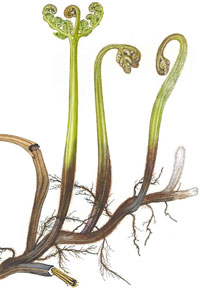Glossary: Rhizomes
Terminology for rhizomes is muddy. Among the many ill-defined terms are clumping, shuttlecock, ascending, erect, creeping, stoloniferous, running, rosette, and tufted. It is not hard to find several of these terms used for the same plant by either one author or different authors.
Here we use only three basic terms, with or without a branching qualifier.
| erect: The plant has a clear center, fronds surrounding that point. Polystichum andersonii is strictly erect, in this case approaching a tree fern in form. | ||
| On the site Woodslore, created by Bors Vesterby, you can find a magnificent portrait with a little hunting. | ||
| erect, branching: While young the plant will be of the form above. Later, branching of the rhizome can lead to two effects. Short branches give a less-centered, more amorphous crown, and the difference between this and the following may not be observable above ground. However, if the branches are longer, the effect is dramatic, as with Matteuccia struthiopteris, a classic erect and branching rhizome. |  | |
| Photo by Anna Lena Anderborg in full size at Den virtuella floran. | ||
| short-creeping: Fronds are generally less than about 1 cm distant, branching is usual, and often unstated. Blechnum penna-marina branches almost as often as it throws up a new frond. | ||
| This photo is by John and Hillary Birks and is seen to better effect on their web site. | ||
| long-creeping: Fronds are generally more than 1 cm distant, branching is usual, and often unstated. Pteridium aquilinum forms extensive colonies, and is the most cosmopolitan, some would say weediest, of ferns. |  | |
| This drawing by Kirsten Tind is given full display on the Pteridium aquilinum page. | ||
Rhizome Indument
The bulk of the rhizome is often below ground, so inspection of its surface hampered. However, the apex of the rhizome is more commonly above ground, even if visibility is impaired by old stipe bases. In some ferns, the nature of the indument can be highly diagnostic, so worth a little effort. Here are the types encountered.
- clathrate scales
- In these scales the individual cells have thick margins, giving a stained glass effect to the scale. This is diagnostic for Asplenium; there are occasional ferns outside Asplenium with clathrate scales, but none on this site.
- peltate scales
- These scales are attached below their centers. This is diagnostic for Polypodium.
- scale-leaves
- Matteucia has scale-leaves on its runners.
- other scales
- Most of the remaining genera have scales on the rhizome, and they are often similar to the scales on the stipes, handy if you cannot see them.
- hairs
- The genera Dennsteadtia, Pteridium, Lygodium, and Osmunda have hairy roots or rhizomes.
- absent
- Gymnocarpium has glabrous rhizomes.